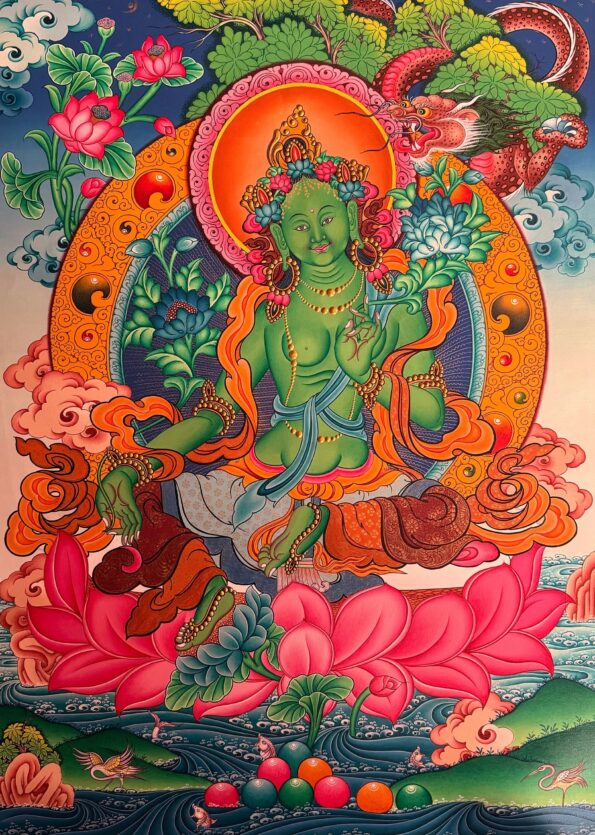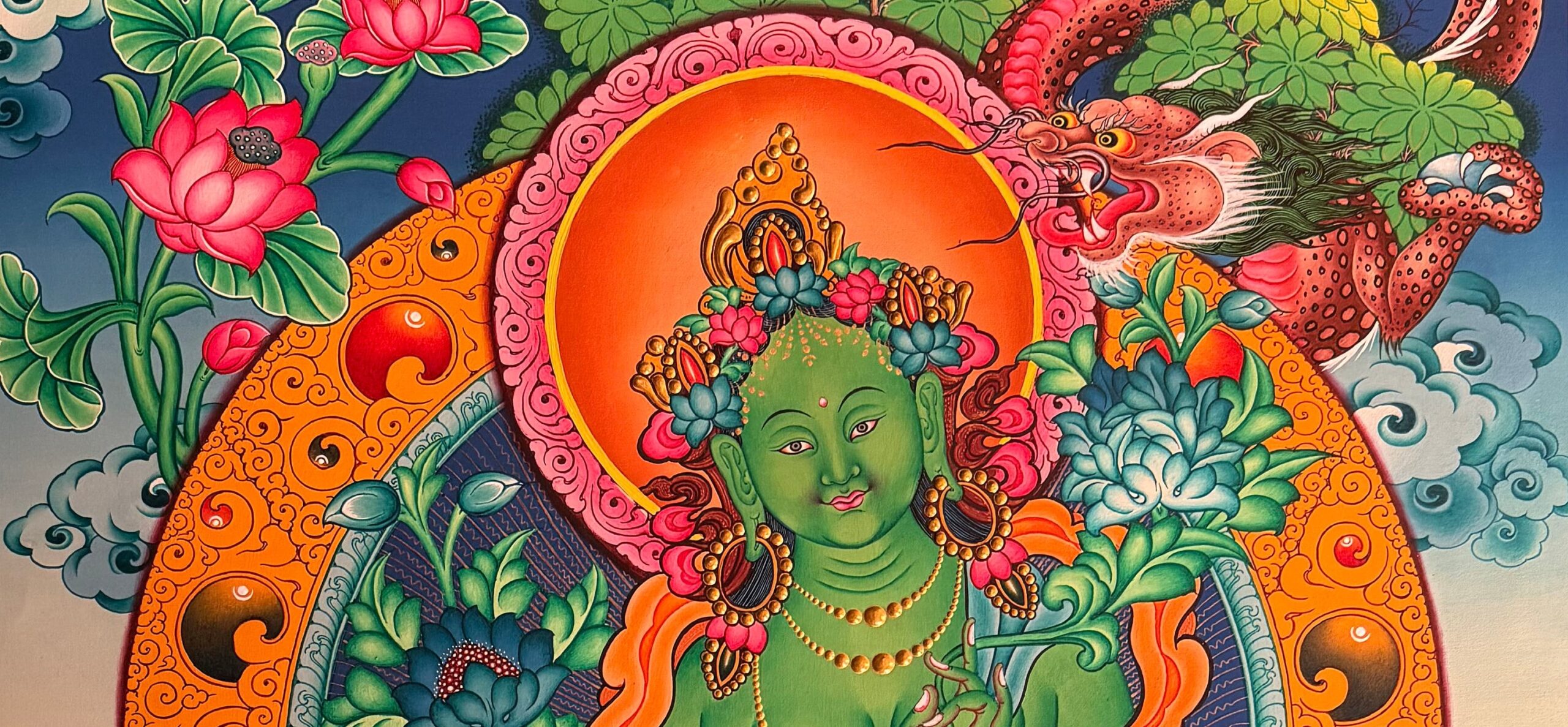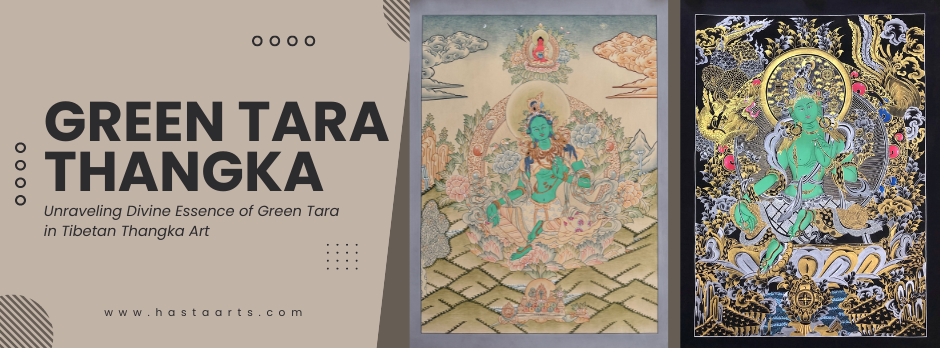A significant figure in Tibetan Buddhism, Green Tara is a prominent deity in the Mahayana and Vajrayana traditions. She is a bodhisattva, a being with profound spiritual realization who chooses to stay in the cycle of reincarnation to assist others in becoming enlightened.
The Origin of Green Tara
The Sanskrit term Tara, which means “savior” or “liberator,” comes from the idea of crossing anything, such as a river, a sea, a mountain, or any other challenging condition.
According to the sutra, the Avalokitesvara Bodhisattva attempted to give the teachings to aid sentient beings, but the beings remained puzzled and did not comprehend, falling into the sea of suffering and death, the cycle of Samsara. Out of compassion for sentient beings, the Avalokitesvara Bodhisattva shed tears, which converted into lotus blossoms, which subsequently transformed into the Green Tara and White Tara. “Don’t be concerned and troubled,” Green Tara advised Avalokitesvara. I’ve promised to assist you. Although sentient beings are infinite, my commitment is likewise infinite.” This is where the name Green Tara comes from.

Iconography and Symbolism
The visual depiction and symbolism connected to a specific god or individual are referred to as iconography. The Green Tara symbolism frequently has the following components:
Color: True to her name, Green Tara is frequently seen with a green body. Green symbolizes energy, life, and rebirth.
Posture: Green Tara is often shown in a seated posture with one leg drawn in and the other extended, ready to spring into action. This position is called “Lalitasana” and represents her ability to swiftly come to the aid of those in need.
Mudras: Tara’s right hand is typically shown in the supreme giving gesture “Varada Mudra”, indicating her preparedness to give boons and blessings to devotees. Her left hand is frequently in the protective gesture “Abhaya Mudra”, providing fearlessness and eradicating fear.
Eyes: Green Tara’s eyes are often depicted as half-open, indicating her watchfulness and readiness to respond to the needs of sentient beings.
Crown and Jewels: To symbolize her regal status as a Bodhisattva, Green Tara is frequently decorated with different decorations such as a crown, earrings, necklaces, and bracelets.
She is frequently shown seated on a lotus flower, which symbolizes her purity and enlightenment as she emerges from the muddy rivers of samsara (the cycle of birth, death, and reincarnation).
A lotus blossom may be seen sprouting at Tara’s shoulder in certain representations, signifying her commitment to aiding and directing creatures toward enlightenment.
A blue lotus, which stands for purity and the conversion of desire into spiritual attainment, is occasionally held in one of Green Tara’s hands.
A crescent moon is frequently shown near Green Tara’s crown, suggesting her connection to the night and her role in removing darkness and ignorance.
Spiritual Significance of Green Tara
Green Tara is revered for her compassionate nature, protection, and swift assistance in times of need. Meditating on or gazing at Green Tara thangka paintings is believed to evoke her blessings, fostering compassion and aiding in overcoming obstacles on the spiritual path. Furthermore, Green Tara is associated with healing and the alleviation of suffering, offering comfort and strength to practitioners facing adversity.

“Green Tara, embodiment of grace, her gaze tender yet resolute, guiding souls through the labyrinth of existence.“
Thangka Paintings: A Gateway to Divine Inspiration
Thangka paintings portraying Green Tara hold profound significance in Tibetan Buddhist culture. Intricately crafted with vivid colors and deep symbolism, these paintings serve as objects of devotion and appreciation. They are utilized in spiritual rituals, celebrations, and daily meditation practices.
For those seeking to deepen their spiritual practice or adorn their sacred spaces with divine imagery, Green Tara thangka paintings offer a gateway to enlightenment and inspiration. Each stroke of the brush captures the essence of Tara’s compassion and wisdom, inviting practitioners to cultivate virtues and engage in compassionate activities in their daily lives.
Discover the transformative power of Green Tara thangka paintings available at Hasta Arts. Immerse yourself in the divine beauty and symbolism of Green Tara as you embark on a journey of spiritual awakening and enlightenment. Shop now and invite the blessings of Green Tara into your life.


